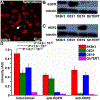Dual-modal in vivo fluorescence and photoacoustic imaging using a heterodimeric peptide
- PMID: 30334022
- PMCID: PMC6357226
- DOI: 10.1039/c8cc06774k
Dual-modal in vivo fluorescence and photoacoustic imaging using a heterodimeric peptide
Abstract
A heterodimeric peptide labeled with IRDye800 is used to perform dual-modal imaging of human esophageal xenograft tumors in vivo. Fluorescence and photoacoustic images provide complementary visualization of tumor dimensions in planar and sagittal views, respectively, demonstrating promise for targeted cancer diagnosis and staging.
Conflict of interest statement
Conflicts of interest
JC and TDW are inventors on a patent filed by the University of Michigan on the peptide heterodimer presented in this study.
Figures






Similar articles
-
Synthesis, Characterization, and Biomedical Applications of a Targeted Dual-Modal Near-Infrared-II Fluorescence and Photoacoustic Imaging Nanoprobe.ACS Nano. 2017 Dec 26;11(12):12276-12291. doi: 10.1021/acsnano.7b05966. Epub 2017 Dec 11. ACS Nano. 2017. PMID: 29202225
-
A Cystine Knot Peptide Targeting Integrin αvβ6 for Photoacoustic and Fluorescence Imaging of Tumors in Living Subjects.J Nucl Med. 2016 Oct;57(10):1629-1634. doi: 10.2967/jnumed.115.169383. Epub 2016 May 26. J Nucl Med. 2016. PMID: 27230926 Free PMC article.
-
A Tumor-Targeting Dual-Modal imaging probe for nitroreductase in vivo.Bioorg Chem. 2024 Aug;149:107531. doi: 10.1016/j.bioorg.2024.107531. Epub 2024 Jun 4. Bioorg Chem. 2024. PMID: 38850779
-
Recent Progress in Small-Molecule Fluorescence and Photoacoustic Dual-Modal Probes for the In-Vivo Detection of Bioactive Molecules.Chem Asian J. 2022 May 16;17(10):e202200155. doi: 10.1002/asia.202200155. Epub 2022 Apr 6. Chem Asian J. 2022. PMID: 35344260 Review.
-
[Development of Molecular Probes Based on Iron Oxide Nanoparticles for in Vivo Magnetic Resonance/Photoacoustic Dual Imaging of Target Molecules in Tumors].Yakugaku Zasshi. 2017;137(1):55-60. doi: 10.1248/yakushi.16-00228. Yakugaku Zasshi. 2017. PMID: 28049896 Review. Japanese.
Cited by
-
Fluorescence Image-Guided Surgery - a Perspective on Contrast Agent Development.Proc SPIE Int Soc Opt Eng. 2020 Feb;11222:112220J. doi: 10.1117/12.2545292. Epub 2020 Feb 19. Proc SPIE Int Soc Opt Eng. 2020. PMID: 32255887 Free PMC article.
-
Targeted contrast agents and activatable probes for photoacoustic imaging of cancer.Chem Soc Rev. 2022 Feb 7;51(3):829-868. doi: 10.1039/d0cs00771d. Chem Soc Rev. 2022. PMID: 35094040 Free PMC article. Review.
-
Review on Optical Imaging Techniques for Multispectral Analysis of Nanomaterials.Nanotheranostics. 2022 Jan 1;6(1):50-61. doi: 10.7150/ntno.63222. eCollection 2022. Nanotheranostics. 2022. PMID: 34976580 Free PMC article. Review.
-
Optimizing Axial and Peripheral Substitutions in Si-Centered Naphthalocyanine Dyes for Enhancing Aqueous Solubility and Photoacoustic Signal Intensity.Int J Mol Sci. 2023 Jan 23;24(3):2241. doi: 10.3390/ijms24032241. Int J Mol Sci. 2023. PMID: 36768560 Free PMC article.
-
PESIN Conjugates for Multimodal Imaging: Can Multimerization Compensate Charge Influences on Cell Binding Properties? A Case Study.Pharmaceuticals (Basel). 2021 Jun 2;14(6):531. doi: 10.3390/ph14060531. Pharmaceuticals (Basel). 2021. PMID: 34199635 Free PMC article.
References
MeSH terms
Substances
Grants and funding
LinkOut - more resources
Full Text Sources

